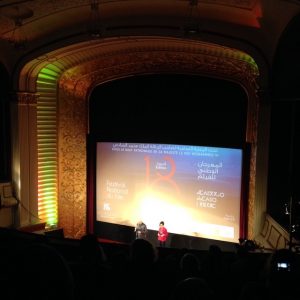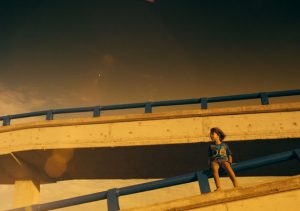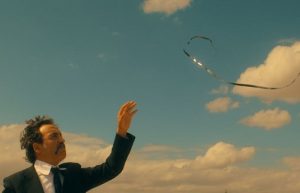Note 1 on the 18th National Film Festival in Tangier (3-11 March, 2017)

Just back from the 18th National Film Festival in Tangier, after having seen this year’s crop of films at the splendid Roxy Theater, downtown. Although smaller in number than last year (15 feature films instead of 25), they tackled a wide array of topics and genres ranging from fiction to documentary.
The theme of return seemed central to the preoccupations of this year’s selections: whether in time (e.g. Ahmed Baidou’s Addour on the resistance of the Amazighen to the French settlers), or in space to a Moroccan “home”.
The latter takes the form of various voyages back: by a child of Moroccan immigrants in Europe (Tarik el Idrissi’s documentary Le Voyage de Khadija/ Khadija’s Journey and Adil Azzab’s hybrid, deeply moving film My Name is Adil); by a Spanish veteran to the Riff region (Mohammed Bouzaggou’s Iperita); by the prisoners kept in terrifying jails by the Polisario (Louba El Younssi’s documentary, Les Miracles d’un serment / Miracles of a Vow).
The question is: to what and to whom exactly do these characters return?
What struck me this time around, especially after the previous year’s productions in which the patriarch was rendered impotent or murdered relentlessly from one film to the next, was the focus on the matriarch in a string of works. Here again, the image of the matriarch was diverse and yielded a complex representation of woman as mother, as abused and occasionally as abuser, as comedic, tragic, tender, brusque, and almost always a Moroccan version of Mother Courage surviving and protecting her brood against all odds.
In the comic register, two films: the long-awaited film by Ahmed el Maanouni, Fadma’s Hand in which Fadma (the mother and grandmother played by Fadila Benmoussa) is always a strong, brave woman who is hilariously funny and travels between Morocco and France, old and new generations, with grace and success. Her presence on screen dominates both literally (via constant close-ups and medium shots) and figuratively (in her dreams she flies over the world and we see her hovering over her sons, the earth, while La Callas sings in the background). This comedy featured actors who are well known TV comedians in Morocco to whom the audience reacted immediately (a strategy also used in The Rooster / Al Farooj (2014) or or La Isla (2015) by Abdellah Ferkous). Fadila Benmoussa plays opposite successful comedian Abderrahmane Ouaabad Eko (Fadma’s younger son, Karim).
The second comedy, Mohamed Achaour’s Lhajjates / The Old Ladies, shows four poor ageing women friends in diverse situations who decide to take revenge on their sad fates by stealing money from Mafioso-like boss who has fired one of them. The film is replete with gags and one-liners that sent the audience roaring with laughter. It features well-known actresses such as Raouia (a top actress in Moroccan cinema) and Fatima Bouchain (Fattouma in Road to Kabul, Brahim Chkiri, 2011).
These funny matriarchs are women without men, fighting for their children or for themselves, and relying on one another in the warmest of female solidarity in a Moroccan urban environment or the depressed Ardennes countryside in France (in the case of Fadma). In short, the patriarch is either off-screen or looming in the distance, occasionally at mid-distance, and the focus rests squarely on the older women and the humor they deploy to deal with daily issues.
In contrast, Hakim Belabbes’s Aida, in Pluie de sueur / Sweat Rain, stands tall, tragic, immensely brave and close to the earth, is stuck in poverty in her little village. Caring for both her son (who has Down syndrome) and her husband (who refuses to sell the land of his ancestors no matter how long the crippling drought lasts, and who keeps referring to his son as “the creature”), she is nurturing (she cooks a lot in the film!), collected, sweet, comforting, and by the end of the film, her identity as wife becomes completely subsumed by her identity as mother. The lavish photography (by Tunisian Amine Messadi) sustains both the epic and intimate dimensions of a family facing the lack of water in this portrayal of survival in rural Morocco: http://www.sweat-rain.com
Even Hicham Lasri’s cartoonish Headbang Lullaby contains an Amazigh female character whose husband has been in prison for years, and who therefore raises her son by herself. This is not the only film that alludes to the emotional and economic price mothers and wives (and their offspring) paid while their husbands were jailed during Hassan II’s years of lead. In this film as well as in Belabbes’s, the female character, deeply rooted in the land, stands strong for herself and others.
In Raouf Sebbahi’s road movie Hayat/Life that follows a bus from Tangier to Agadir and the crisscrossing stories that emerge from its newly created community of diverse passengers (very funny in places), also zooms in on women characters: a grandmother and her granddaughter, Hayat, traveling together, a middle-aged woman returning to Morocco, and finally a young woman reaching motherhood (she gives birth on the bus, helped by a doctor on board).
The apparent recurrence of the matriarch (whether a grandmother or a mother) on screen was also visible in some of the fifteen shorts. For example, Ayoub Laoussifi’s Tikitat a’Soulima / The Cinema Ticket tells the story of a little boy raised by a single mother (whose husband, once again, is in jail) who is harsh on him but ends up reconciled with him thanks to cinema. Karima Zoubir’s Derrière le mur / Behind the Wall shows a humble couple sharing an egalitarian view of the education of their daughter Nadia while Hicham Regragui’s Ima / Mother shows an old matriarch revealing a secret to her children before she dies. However, not all female figures are positive: a disturbing short, Dimma Bounaylat’s No evokes the rape of a little boy by a mature woman and the disastrous effects on his sexuality and view of women which will lead to murder.
So, what’s with all these matriarchs on screen this year? Perhaps, once the illusion of male power has been shattered on screen, the only remaining solid anchor available for one’s identity is the female one (even if No cautions against possible abuse). This recurring positioning of women at the center or close to the center of the filmic narrative while taking into account the emigration (Adil Azzab’s My Name is Adil), jail sentences, poverty of men, also focuses on women who speak, sing, feed and comfort; women who give birth and raise children, generation after generation. In the wake of Yasmine Kassari’s L’Enfant endormi (2004) on men’s migration to the North leaving their women behind to till an arid land and raise babies alone, this year’s films affirm that matriarchs and their daughters endure.
Florence Martin

